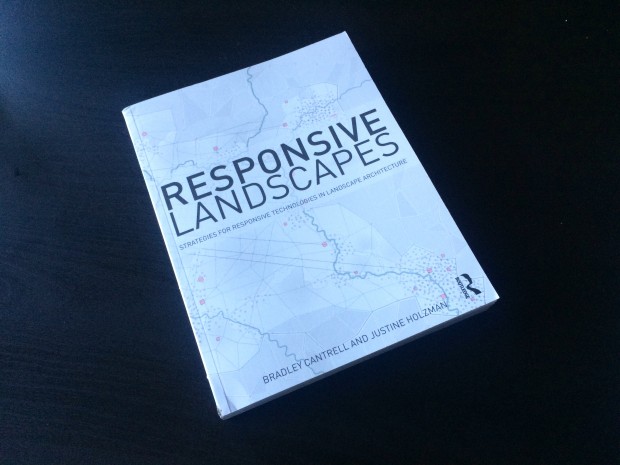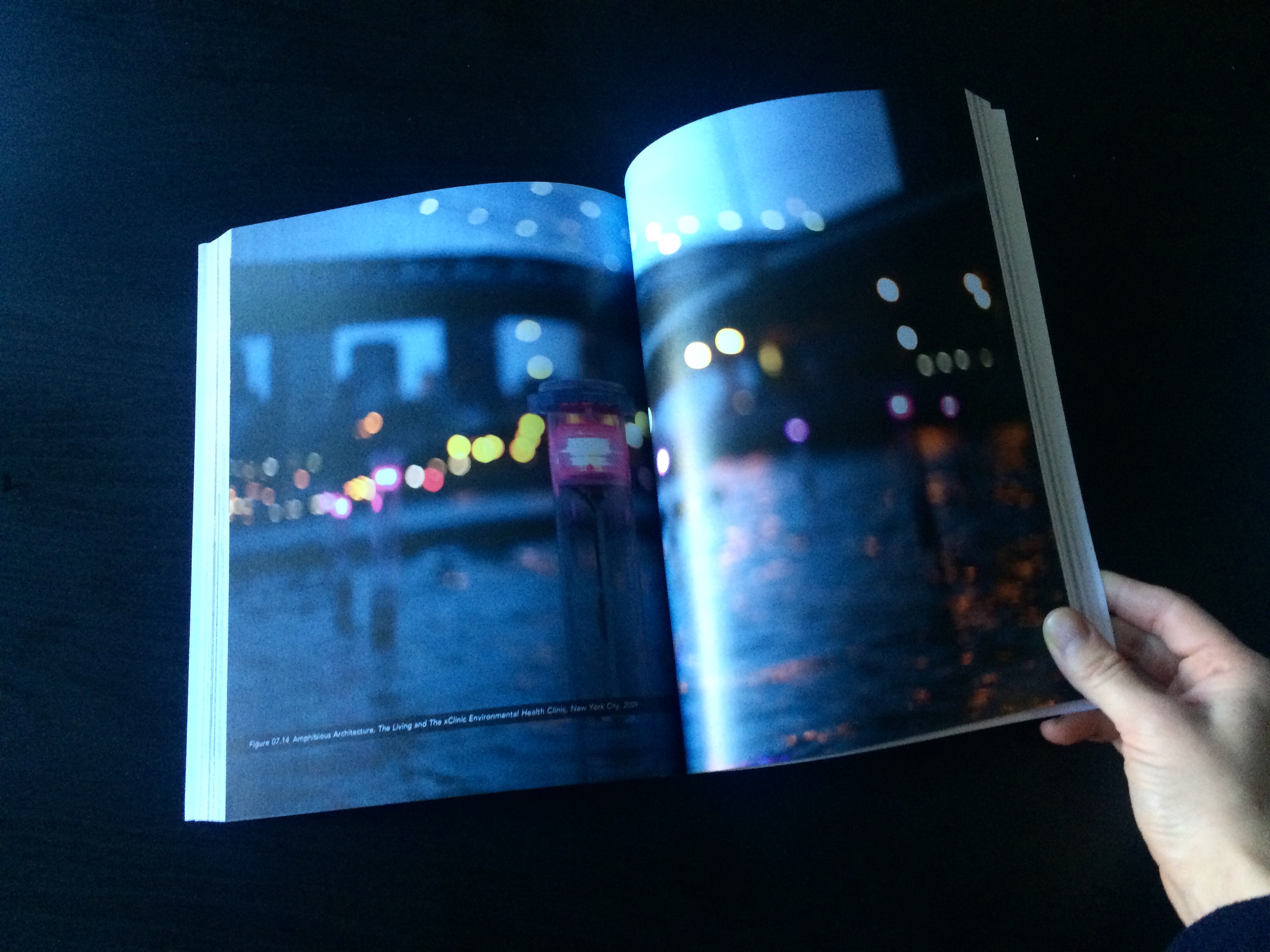R E S P O N S I V E L A N D S C A P E S :
Strategies for Responsive Technologies in Landscape Architecture
Blurb:
The sensing, processing, and visualizing that are currently in development within the environment boldly change the ways design and maintenance of landscapes are perceived and conceptualized. This is the first book to rationalize interactive architecture and responsive technologies through the lens of contemporary landscape architectural theory.
Responsive Landscapes frames a comprehensive view of design projects using responsive technologies and their relationship to landscape and environmental space. Divided into six insightful sections, the book frames the projects through the terms: elucidate, compress, displace, connect, ambient, and modify to present and construct a pragmatic framework in which to approach the integration of responsive technologies into landscape architecture. Complete with international case studies, the book explores the various approaches taken to utilize responsive technologies in current professional practice. This will serve as a reference for professionals and academics looking to push the boundaries of landscape projects and seek inspiration for their design proposals. Get the book here.
Authors:
Bradley Cantrell is an associate professor at the Harvard Graduate School of Design and design researcher at Invivia whose work focuses on the role of computation and media in environmental and ecological design. Professor Cantrell received his BSLA from the University of Kentucky and his MLA from the Harvard Graduate School of Design. He is the author of the ASLA award-winning book Digital Drawing for Landscape Architecture and Modeling the Environment.
Justine Holzman is a landscape researcher and Adjunct Assistant Professor at the School of Landscape Architecture at the University of Tennessee, Knoxville, USA. She received a BA in Landscape Architecture from the University of California Berkeley and an MLA from the Robert Reich School of Landscape Architecture at Louisiana State University. Her current research recognizes the inherent responsive capabilities of landscape through its materiality and her work in ceramics and digital fabrication has been exhibited across the United States.
Contents:
Foreword by Nataly Gattegno and Jason Kelly Johnson of Future Cities Lab: “Towards a Robotic Ecology”
The book includes case studies of the following projects:
E L U C I D A T E →
- Wind Screen, Höweler + Yoon Architecture, Cambridge, Massachusetts, 2011
- Dune 4.2, Daan Roosegaarde, Studio Roosegaarde . Esch, Rotterdam, Netherlands, 2010
- Nuage Vert “Green Cloud”, Helen Evans and Heiki Hansen, HeHe . Helsinki, Finland, 2009
- Confluence, SCAPE / LANDSCAPE ARCHITECTURE and The Living . Pittsburgh, Pennsylvania, 2012
C O M P R E S S →
- The Theater of Lost Species, Nataly Gattegno and Jason Kelly Johnson, Future Cities Lab . San Francisco, California, 2014
- Emergence, Obscura Digital . San Francisco, California, 2013
- Interview with Garth Williams
- Datascape, Yitian Wang, Yi Liu, Matty A. Williams, Synthetic Urban Ecologies Studio . West Oakland, California 2013
D I S P L A C E →
- Living Light, David Benjamin and Soo-in Yang, The Living . Seoul, Korea, 2009
- Scent Garden, Rodolphe el-Khoury, Drew Adams, James Dixon, and Fadi Masoud . Xi’an, China, 2011
- Datagrove, Nataly Gattegno and Jason Kelly Johnson, Future Cities Lab . San Jose, California, 2012
- Pachube, Xively, Thingful, Usman Haque, Usman Design + Research (which is now Umbrellium) . Web-based Platform, London, 2008
- Local Code, Nicholas de Monchaux . San Francisco, California, 2012
- Interview with Nicholas de Monchaux
- Rapid Landscape Prototyping Machine, Alexander Robinson, University of Southern California Landscape Morphologies Lab, Owens Lake, California 2011
C O N N E C T →
- MIMMI, INVIVIA and Urbain DRC . Minneapolis, Illinois, 2013
Interview with Allen Sayegh - Aviary, Höweler + Yoon and Parallel Development with sound composition by Erik Carlson . Dubai, United Arab Emirates, 2013
- Sky Ear, Usman Haque, Haque Design + Research (which is now Umbrellium) . Fribourg Switzerland and Greenwich, London, 2004
- Amphibious Architecture, The Living and the xClinic . New York City, 2009
- H.O.R.T.U.S, Claudia Pasquero and Marco Poletto, ecoLogic Studio . London, United Kingdom, 2012
- Augmented City 3D, Keiichi Matsuda . London, 2010
- Interview with Keiichi Matsuda
A M B I E N T →
- Bloom, Doris Sung, Ingalill Wahlroos-Ritter, Matthew Melnyk, dO|Su Studio Architecture . Los Angeles, California, 2012
- Reef, Rob Ley and Joshua Stein . New York City, 2009
- Interview with Joshua Stein
- METAfollies, Claudia Pasquero and Marco Poletto, ecoLogic Studio . Orleans, France, 2013
- Epiphyte Chamber, Philip Beesley . Seoul, Korea, 2014
M O D I F Y →
- Open Columns, Omar Khan and Laura Garofalo . Buffalo, New York, 2007
- Smart Highways, Studio Roosegaarde and Heijmans Infrastructure . Netherlands, 2013
- Interview with Daan Roosegaarde
- Vacuolar Effluvia Genesis, Josh Brooks and Kim Nguyen, LSU Responsive Systems Studio . Atchafalaya Basin, Louisiana, 2011
- Pod Mod, Charlie Pruitt, Brennan Dedon and Rob Herkes, LSU Responsive Systems Studio . Atchafalaya Basin, Louisiana, 2011
- Synthetic Mudscapes, Jeff Carney, Bradley Cantrell,Matthew Seibert, Liz Williams, LSU Coastal Sustainability Studio . Mississippi River Delta, Louisiana, 2013

